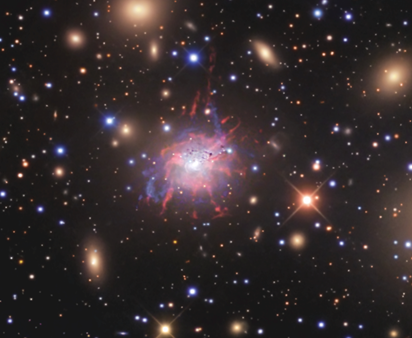
Globular clusters may contain hundreds of thousands of stars and may even have as many as ten million stars that essentially emerged at the same time. They are the oldest visible objects in the universe. Globular clusters come together in dense, spherical volumes with diameters hundreds of times smaller than the diameter of our galaxy. The Milky Way is surrounded by about 150 globular clusters, some of which are visible in the darkness of the night; but about ten or twenty thousand globular clusters can be found around the giant galaxies located at the centre of the galaxy clusters. Galaxy clusters contain hundreds or thousands of galaxies bound together by gravity and infused by hot gas (over ten times hotter than that at the Sun’s core).
These globular clusters are thought to have formed shortly after the birth of the universe about 13,800 million years ago, at the same time or even before the first galaxies formed. Since then, they have remained largely unchanged apart from the ageing of all their stars and the gradual death of most of the remaining stars.
Thomas Broadhurst, the Ikerbasque Research Professor at the UPV/EHU’s Department of Theoretical Physics and History of Science, explained that “it is not fully understood why the brightest galaxies form in the centre of the galaxy clusters. The fact that they contain thousands of old globular clusters may be a point to take into consideration.” A study led by Dr Lim of the University of Hong Kong and published by the prestigious journal Nature Astronomy, and in which Broadhurst collaborated, has found unexpected answers to the origin of some globular clusters located around the giant galaxies at the centre of galaxy clusters: “We discovered that thousands of new globular clusters have been forming over the last billion years out of a cool gas in the giant galaxy located in the centre of the Perseus galaxy cluster,” explained Prof Broadhurst.
The younger globular clusters are closely associated with, and therefore formed from, a complex network of cool gas that extends to the outer reaches of the giant galaxy. This network of cool gas precipitates from the hot gas that infuses the entire Perseus galaxy cluster; in fact, the gas concentrates in the centre allowing it to cool faster and that leads to the creation of globular clusters. Once formed, these infant globular clusters do not remain in the network of cool gas and rain inwards onto the giant galaxy like raindrops falling from the clouds. “So,” explained Broadhurst, “one could expect that the central galaxies of these clusters will grow in brightness over cosmic time as a result of the rain of globular clusters they receive from the gas that surrounds them”.
For more information: https://doi.org/10.1038/s41550-019-0909-6
.png)
